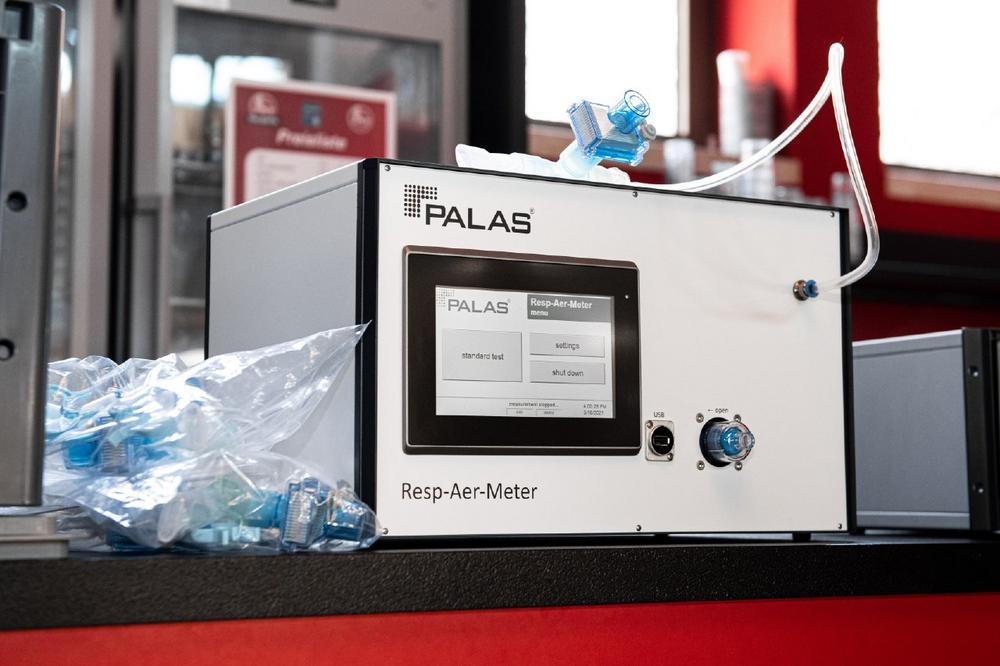It is well known that the corona virus is spread via the air or aerosols. However, what many people do not know: The number of exhaled aerosols gives an indication of changes in the lungs and the potential risk of infection posed by the infected person. "Not everyone who is ill is equally infectious and passes on the disease. To determine this, the Resp-Aer-Meter can make an important contribution and make infections more visible," explains Dr. Maximilian Weiß, CEO of Palas GmbH.
How the Resp-Aer-Meter works
To measure the aerosol concentration in the exhaled air, the test person breathes into the Resp-Aer-Meter. The evaluation is immediate – in contrast to PCR tests, for example: the device determines how many particles of what size are present in the breath. This is an indicator for a possible disease. If a certain value is exceeded, the person concerned is considered infectious and can thus be isolated from the group before infecting other persons.
An important building block for greater safety
In contrast to standard test procedures, the Resp-Aer-Meter does not simply show a positive or negative result, but also the quantitative degree of the potential risk of infection and contagion. It is thus another important component in the fight against the pandemic. "In addition to the Corona safety rules and the vaccination offer, we are using more and more PCR and rapid tests, the reliability of which is not always ensured”, says Dr. Maximilian Weiß. He even goes one step further: "With the additional use of this device, measures to contain the pandemic can be optimized. For example, regarding quarantine times. Those who are not infectious do not have to remain in quarantine longer than necessary."
Study shows significant differences between COVID-19-positive and -negative individuals
In the recent, pre-published study "Aerosol measurement identifies SARS-CoV 2 PCR positive adults compared with healthy controls" at Frankfurt University Hospital (Preprint, https://doi.org/10.1101/2022.01.21.22269423), a significant increase in aerosol output was found in COVID-19-positive individuals compared with the healthy control group using the Resp-Aer-Meter. Identification based on the aerosols measured by the Resp-Aer-Meter can be made in this case in very good agreement with the PCR tests. The increased aerosol concentration is due to changes in the lungs and airways as a result of the infection. In addition, it was shown that within the positive group of individuals there is considerable variation in the number of aerosols exhaled and a few individuals become superspreaders. They have a particularly high number of pathogens in the air they breathe and are considered to be particularly infectious.
This finding shows the great potential offered by a systematic recording of aerosol concentrations in the respiratory air: in the study of respiratory and pulmonary diseases, as well as the early detection of superspreaders.
Also in a second preliminary publication, in which the Resp-Aer-Meter was used, significantly increased aerosol concentrations were shown for the diseased persons.
Further fields of application
The possible applications are very versatile, for example in the event sector and for access control. For example, the German handball league club MT Melsungen is testing its players and employees with the Resp-Aer-Meter before each encounter in order to detect a possible infection at an early stage.
Further applications can be found in hospitals and in science. This is because the exhalation device also offers a wide range of additional information and data and is particularly suitable for scientific and medical purposes. The device can also be used to gain new insights in research and development – for example in the field of pneumology. Possible questions here are: Do infectious respiratory diseases differ by exhaled particle size distribution? Is an increased particle concentration in the breath due to a certain particle size range? How do disease variants or personal characteristics (age, BMI, previous diseases) influence the result?
The Palas GmbH is a leading developer and manufacturer of high-precision devices for the generation, measurement and characterization of particles in the air. With numerous active patents Palas® develops technologically leading and certified fine dust and nanoparticle measuring devices, aerosol spectrometers, generators and sensors as well as associated systems and software solutions. Palas® was founded in 1983 and employs about 90 employees at the company headquarters in Karlsruhe. Palas GmbH is a subsidiary of Brockhaus Capital Management AG, which is listed in the Prime Standard at the Frankfurt Stock Exchange (BKHT, ISIN: DE000A2GSU42).
Palas GmbH
Siemensallee 84 | Gebäude 7330
76187 Karlsruhe
Telefon: +4972196213132
Telefax: +49 (721) 96213-33
http://www.palas.de
Head of Marketing & Communication
Telefon: +49 721 96213 133
E-Mail: eva-maria.erler@palas.de
![]()
